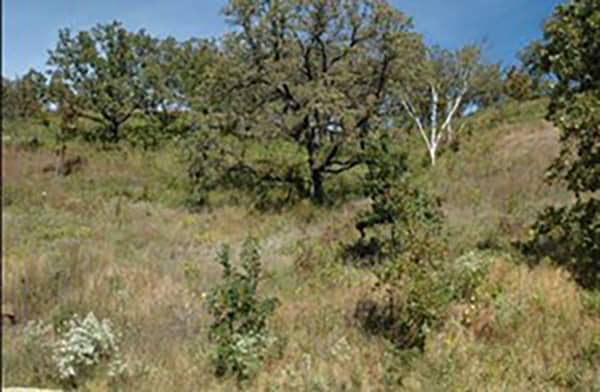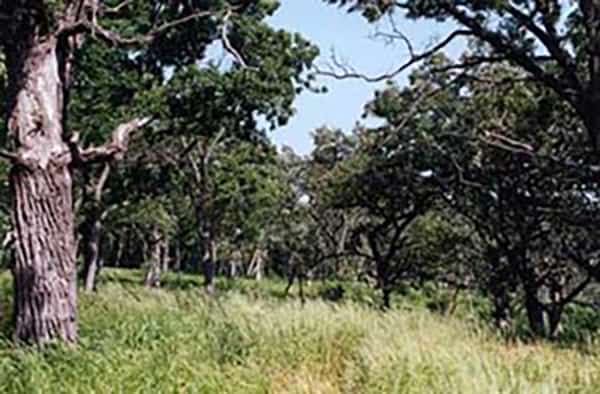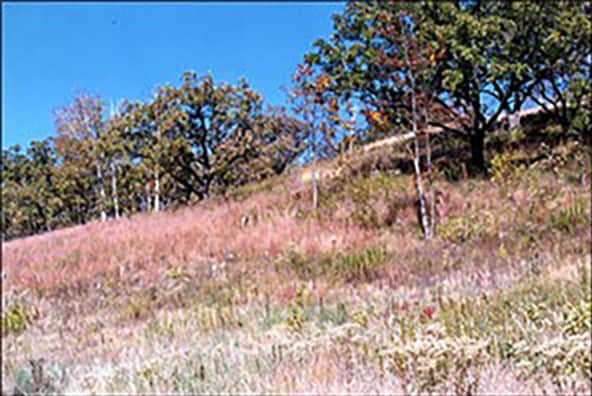
Pleasant Valley Conservancy
Pleasant Valley Conservancy State Natural Area is a 140-acre natural area in western Dane County. It consists of extensive restored oak savannas, dry, mesic, and wet prairies, wetlands, and oak woods. It is in the Driftless Area of Wisconsin and is in the Hill and Valley Province.
Scenic views and wildlife viewing are excellent, and a hiking trail brings one into the heart of the savanna. Thirty-seven acres were donated to The Prairie Enthusiasts in 2006, along with a conservation easement on the remaining land.
There is an extensive website that was developed by Tom Brock with information about the site and it’s management. While this webpage contains some basic information on the site, please visit that website to learn even more!
ACCESS & DIRECTIONS
*** THIS SITE IS CURRENTLY CLOSED TO THE PUBLIC ***
Description & Significance

The steep south-facing ridge supports several prairie remnants, which are now thriving after intensive management began in 1995. The oak savannas, primarily on the ridge top, contain numerous large, open-grown bur and white oaks with many being over 150 years old. This area supports numerous grass, sedge, and forb species including the state-endangered purple milkweed (Asclepias purpurascens), which re-appeared after restoration and prescribed burning began.
The cooler north-facing slope is predominantly oak woodland with red oak, basswood, hackberry, butternut, yellowbud hickory, and red maple. The woodland contains a good variety of spring ephemerals.
The savanna and oak woodland support a diversity of bird species which include the red-headed woodpecker, a declining bird species of conservation concern. Other birds include blue-gray gnatcatcher, eastern wood pewee, tufted titmouse, eastern bluebird, yellow-throated vireo, scarlet tanager, black-billed cuckoo, and yellow-billed cuckoo.
Also present is the spring-fed Pleasant Valley Creek, which flows through the wetland and into East Blue Mounds Creek.
Notable Species:
South-Facing Prairie Remnant:
- big bluestem (Andropogon gerardii)
- little bluestem (Schizachyrium scoparium)
- Indian grass (Sorghastrum nutans)
- side-oats grama (Bouteloua curtipendula)
- wood betony (Pedicularis canadensis)
- bird’s foot violet (Viola pedata)
- purple prairie clover (Dalea purpurea)
- violet wood sorrel (Oxalis violacea)
- prairie turnip (Pediomelum esculentum)
Oak Savanna:
- purple milkweed (Asclepias purpurascens)
- silky rye (Elymus villosus)
- bottlebrush grass (Elymus hystrix)
- ear-leaved brome (Bromus latiglumis)
- leadplant (Amorpha canescens)
- large-flowered yellow false foxglove (Aureolaria grandiflora)
- Canada milk-vetch (Astragalus canadensis
- Illinois tick-trefoil (Desmodium illinoense)
- prairie alumroot (Heuchera richardsonii)
- shooting star
- spiderwort
- giant yellow hyssop (Agastache nepetoides) – state threatened
- upland boneset (Eupatorium sessilifolium) – special concern
North-Facing Slope:
- bloodroot (Sanguinaria canadensis)
- Jacob’s ladder
- large-flowered bellwort- (Uvularia grandiflora)
- yellow lady’s slipper orchid (Cypripedium parviflorum)
- large flowered trillium (Trillium grandiflorum)
- Dutchman’s breeches (Dicentra cucullaria)
Natural History

Pleasant Valley Conservancy consists of a long narrow ridge that runs almost due east/west, with steep hillsides facing both north and south. The north-facing slope is cool and moist and the vegetation is primarily oak woods. The south-facing slope receives the full brunt of the sun and is hot and dry. Its vegetation consists of oak savanna and prairie. Pleasant Valley Conservancy is part of the unique “Driftless Area” of southwestern Wisconsin, an area that the glaciers never reached. Surveyors notes and plant surveys tell us that the dominant vegetation before settlement was oak savanna, with areas of prairie along the edges of the streams and on the steepest south-facing slopes. The spring-fed Pleasant Valley Creek flows through the property, feeding into Blue Mounds Creek. Along the creek valley is an area of marsh and wet prairie.
The property was owned by the Lockwood Family for many years and was in general agricultural use from the 1880s through the 1950s. However, only about 15 acres of the property was ever in cropland (now planted to prairie). The rest was pasture, woodland, or wetland. After the early 1960s the property was in absentee ownership until Kathie and Tom Brock purchased it in 1980.
An air photo by the Soil Conservation Service, done in 1937, shows that the south-facing slope was predominantly prairie and oak savanna. The Wisconsin Land Cover map for the Town of Vermont, done around the same time, provides a similar picture. Most of the south-facing slope was probably pastured, but very slightly. Subsequent air photos show that after the 1950s, the south slope gradually deteriorated, losing its open character.
At the time restoration began in 1995, there was a small native “goat” prairie at the west end of the hill. The remaining parts of the south slope had small amounts of remnant prairie vegetation which were virtually overgrown with planted red pines, native red cedars, and invasive trees and shrubs such as black walnut, buckthorn, and honeysuckle. These woody plants were cut and removed from the south slope during the winter of 1997-98. Controlled burns were begun In the spring of 1998 and were extremely successful, leading to a resurgence of original prairie. Continued burns since then have returned the whole south slope to prairie.
At the time restoration began, the upper slope and the ridge top had many large open-grown oaks (mostly bur but some whites), but they were overun with invasive trees and shrubs. During the 1999-2003 period, most of this invasive woody vegetation was removed, and controlled burns were introduced, which were quite effective. Remnant herbaceous vegetation growing in a highly suppressed form was released. Continued burning at yearly intervals have encouraged further savanna vegetation. Careful monitoring and control of invasive shrubs has kept the savannas open.
Although the wetland had been tiled, it was abandoned to agriculture in the 1950s and the tiles gradually broke. Today, the wetland is of high quality and is fairly large for the Driftless Area. Many springs arise in the wetland and contribute water to a small creek that flows through the east end. Also, Pleasant Valley Creek is on the Conservancy and flows through the west end of the wetland. This cold-water spring-fed creek supports many wetland forbs and sedges. Reed canary grass, a common bane of wetlands, is present in only low amounts.
Volunteers
Various volunteer activities are carried out throughout the year. To be placed on a special email list for Pleasant Valley Conservancy, send an email or call site steward Kathie Brock.
Usage Policies
Currently not open to the public.
Ownership History
The Prairie Enthusiasts owns outright 37 acres of Pleasant Valley Conservancy and owns a permanent conservation easement on the remaining land. The 37 acre parcel had been owned by the Savanna Oak Foundation, Inc., a nonprofit foundation established by Tom and Kathie Brock. Savanna Oak donated this parcel gratis to The Prairie Enthusiasts in 2006.
The conservation easement on the remaining land was donated gratis to the Prairie Enthusiasts by Tom and Kathie Brock in 2006.
Pleasant Valley Conservancy was designated a State Natural Area in 2007.
Management
Some of the management activities of Pleasant Valley Conservancy have been supported by grants from the U.S. Fish and Wildlife Services (controlled burns of the wetland), Wildlife Habitat Incentive Program of the U.S. Department of Agriculture (oak savanna restoration), and Landowner Incentive Program of the Wisconsin Department of Natural Areas. The Conservation Reserve Program of the U.S.D.A. has also permitted us to plant prairie on our four CRP fields.
However, most of the restoration work at Pleasant Valley Conservancy has been supported by Tom and Kathie Brock through their Savanna Oak Foundation, Inc.
Management activities include the following (visit the Brocks’s website to see the details): controlled burns, seed collection and planting, on-going brush control, weed control, and plant species monitoring.
